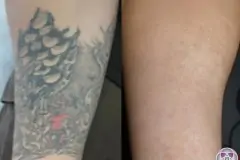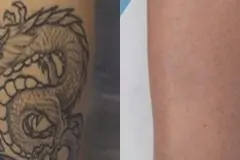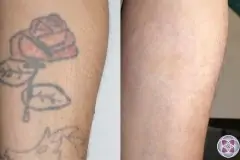
OC 949-428-4500
LA 310-460-2444
Today you have it, tomorrow it’s gone! First comes the romance… then the mystery… then the body art… and then come the dreams, empowered by the feelings of destiny unfolding…
We get it… Using your body as a canvass to express your purpose in life is a magical process and a powerful experience. For some it connects you to cultures all around the world and throughout history who found similar meaning in carrying the power and magic of art, as a part of your body… even if no one sees it but you.
But then, for whatever reason, the time arrives… and you want to clear the canvas. It’s time to get the tattoo removed.




Laser tattoo removal works by targeting pigments that are found in tattoo ink. Each color will absorb a specific wave frequency of laser energy/light. Therefore, if your tattoo has many colors, you will need specific lasers with different frequencies of energy/light that will be absorbed by each color ink.

When the tattoo ink absorbs the correct frequency of laser light, the ink molecules are either vaporized or shattered depending on the “speed / length” of the laser pulse. Either way, once the ink has been disrupted, your body’s immune system will absorb the ink fragments and dissolve them away.
The most common type of lasers used for removing tattoos are:
The Q-switch: It produces energy pulses that are measured in thousands of a second. Lasers using Q-switched technology can generate short-duration light pulses with substantially higher peak power than continuous wave output.
The PICO: It produces energy pulses in billionth of a second. Recently, lasers with even shorter pulse durations have been produced, potentially allowing better chromophores targeting while causing less damage to adjacent tissue.Black, blue, brown and dark blue respond the best to laser treatment while red, purple or orange present more of a challenge.
Yellow and green have historically been the most difficult to “erase.” However, since the invention of the PICO laser, these colors can now be properly treated. They due however require 2-3 further sessions to remove any leftover shadows that may appear.
Various laser wavelengths and the colors they work best on.
Amateur or poorly applied tattoos may not respond as well as professional tattoos.
A number of factors influence this difficultly, such as poor-quality ink, or ink that is inserted too deep in the skin where lasers cannot effectively penetrate.



Just a few years ago there were lasers that could clear most of the ink… though it took many painful treatments and often left a shadow of certain colors that were hard to clear.
And Now…. There is the newly invented PICO laser, which can give you the best results ever, with fewer and less painful laser tattoo removal treatments.
Even better… if you want, the treatments can be entirely painless, by having our physicians anesthetize your skin during the procedure.Immediately after the procedure, the treated area will have a whitish / grey or red discoloration with pinpoint bleeding. There may also be some blistering or slight oozing. Localized swelling it typical and may last 3-5 days.
Most practices will provide the patient with topical antibiotic ointment and a soothing moisturizer that keeps the area from drying out. Icing may also speed up recovery, and over the counter pain medications such as Tylenol can help “take the edge off”.
The most important recovery protocol is to use common sense. Don’t aggravate the treated skin. Keep it clean. Protect it from contamination. Protect it from drying out. Keep it out of the sun. DON’T PICK AT IT!!!For 2-3 weeks following your treatment to remove your tattoo, you may see, peeling, and/or scabbing and/or flaking of the treated area. Be gentle. NO scrubbing! While the treatment site is healing, avoid sun. Keep the area clean and well moisturized with a cream that allows your skin to breath! (Not Vaseline or other petroleum jellies)
When the site is completely healed, you are ready for another laser treatment.









A. When the laser energy is absorbed by the tattoo ink the ink is actually vaporized and explodes very similar to a little steam explosion. This little steam explosion causes a sore by disrupting the surrounding tissue. The swelling that you see is part of the normal inflammatory process of healing. Therefore, as the skin heals, the bumps will go away.
A. Good question… Absolutely not! The energy that medical lasers emit is NOT the kind of laser energy that can cause cancer.
A. When done correctly by an experienced professional, with the proper devices, removing a tattoo can be very effective and leave no scarring. The treatments can also be completely painless with the use of an anesthetic.
A. For the majority of people the tattoo hurt going in and it will hurt coming out. However, it doesn’t have to hurt coming out. It is completely dependent on the patient whether we may or may not need to use an anesthetic. Their skins condition, where the tattoo is located on their body, the amount of ink that was used, the depth, size and age of the tattoo.
If anesthetic is appropriate, or the patient simply wants us to take the edge off, there are a number of options. A topical numbing cream along with an over-the-counter pain killer such as Tylenol is usually enough to reduce the sensation to a tolerable level.
For a patient who is particularly sensitive or who has a tattoo in a particularly sensitive spot we can administer something called tumescent anesthesia. This typically results in the patient feeling no pain at all as an anesthetic solution (lidocaine) is injected directly under the skin where the tattoo is located. This form of anesthetic will increase the cost of removing the tattoo as more time and resources are required.
A. It is bad news to have mercury anywhere in your physiology. It is best to get rid of it as it is the mother of all inflammatory heavy-metal toxins.
Regarding mercury that is in tattoo ink, fortunately, from what I am able to find, tattoo ink today does not contain mercury. If your tattoo does contain mercury, it is a very good idea to get it out of your skin. The only way of doing this that I know works is with laser treatment. Be sure to alert your practitioner that your tattoo may contain mercury. They will need to protect themselves, and you, from inhaling the mercury that the tattoo removal laser is vaporizing.
A. For complete tattoo removal, most individuals choose one of three surgeries: dermabrasion, surgical excision, and laser tattoo removal.
Dermabrasion is typically the cheapest option and essentially involves sanding off the tattoo.
Surgical excision is the most suited for smaller tattoos, but it is the most invasive.
The gold standard of tattoo removal is laser tattoo removal. It is the best procedure for completely removing tattoos. It also carries the lowest risk of scarring and other negative side effects.
A. Cost depends on the size of the tattoo and the type of pigments used. Darker inks, for example, are easier to treat than pastels.
On average, the cost is $150 for the first square inch plus $50 per additional square inch. This is per treatment.
Typically, 5 to 10 treatments are needed to completely remove a tattoo.
A. 5-10 sessions are typical and in rare cases 15-20 sessions are sometimes needed.
The number of treatment sessions required is also determined by pigment color, composition, density, depth, tattoo age, body location, and the amount of tattoo ink present.
A. Though many factors influence the outcome, we have divided them into three logical categories:
A. While no single laser system can remove all tattoos, Q-switched lasers can successfully fade most tattoos with minimal side effects. As the demand for getting a tattoo grows, research into tattoo removal will too with the development of picosecond and femtosecond laser technologies.
AMA Regenerative Medicine & Skincare | 1570 Brookhollow Dr., Santa Ana, CA 92705 | 6310 San Vicente Blvd STE 285, Los Angeles, CA, 90048 | Privacy Policy